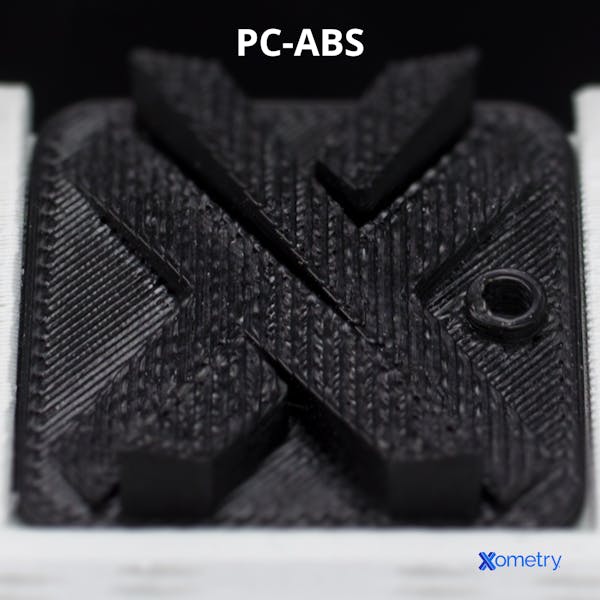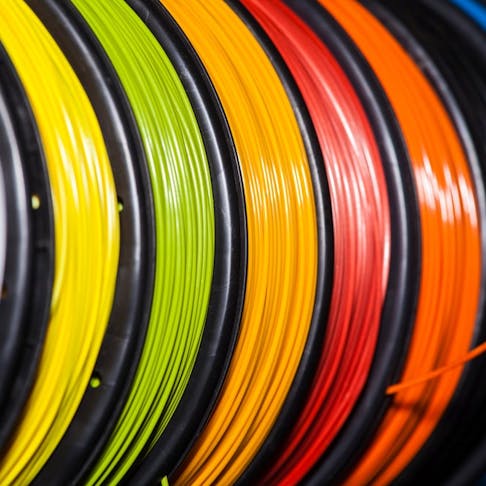PC-ABS is the superstar of plastics thanks to its exceptional strength and durability, and also how easy it is to work with—always a winning characteristic. It’s a hit in many industries, such as automotive, electronics, and 3D printing, for things like functional prototypes, structural components, and end-use parts that also have the extra advantage of being aesthetically appealing, too. Read on to find out why.
What is PC-ABS?
Two of the most common manufacturing thermoplastics are polycarbonate (PC) and acrylonitrile butadiene styrene (ABS). PC is tough and heat resistant, and ABS is flexible and processable. What do you get if you cross PC and ABS? A hybrid plastic with all the aforementioned perks (and then some) called PC-ABS. So, what specifically is so special about it? We can think of six things in particular and break these down below.

1. It’s lightweight
We can understand how lightweight a material is by its density, or how much it weighs for a given size. The density of this material can vary on the PC to ABS ratio, but typically it’s around 1.15g/cm³. To help you see how impressive this is, here are some other comparable densities of some other thermoplastics:
- Polyethylene terephthalate (PET): 1.35g/cm³
- Polyvinyl chloride (PVC): 1.16–1.45g/cm³
- Polylactide (PLA): 1.25g/cm³
- Polyetherimide (PEI): 1.3g/cm³
- Polypropylene (PP): 0.9g/cm³
PC-ABS is not quite the lightest of them all, but given its strength and resistance to various elements, it’s pretty impressive.
2. It’s glossy and can be colored
In relation to transmittance and optical nature, PC is clear, but ABS is opaque, which makes PC-ABS somewhat cloudy. A material’s transmittance refers to how much light passes through a material compared to how much hits it. For example, concrete has almost zero transmittance, but glass is near-perfect in terms of its optical nature. So, while PC-ABS can’t replace PC in many optical applications, it does retain the glossy surface of ABS and reflects light pretty well, even having a mirror-like shine if it’s polished properly. It can also easily be colored, pigmented, and painted.
3. It’s heat resistant
Heat resistance is a material’s ability to withstand heat without losing any of its general properties. Thanks to the PC included, PC-ABS has quite a good resistance to heat. It’s even more impressive because ABS has terrible thermal resistance, so by using this material, you can enjoy the aesthetic appeal of ABS without burning the part. This goes for most variations of PC-ABS, but as the ratio of its contents changes, its heat resistance will change too, and in turn, so will its flow characteristics, workability, and processability.
FREE Injection Molding Design Guide
4. It’s tough with high-impact strength
PC-ABS has both toughness and impact resistance in abundance. These two features are not the same thing, although you could be forgiven for thinking otherwise. When we’re describing material properties, “toughness” is how much energy or force it can absorb/take without cracking. The “impact resistance” is how well it can deal with a single, sudden hit. So, just because a material is hard, that doesn’t mean it’s tough at all. Probably the best examples are ceramics and glass, which are very hard but not at all tough.
PC-ABS is especially good at keeping its toughness at low temperatures, where even some metals could crack. And thanks to the ABS, not only is it tough, but it’s flexible too so that it can bend without breaking easily—yet another reason it’s made into parts for vehicle interiors and electronic appliances.
5. Overall good mechanical properties
In the table below, we go through some of the mechanical properties of this material and their importance to PC-ABS as an engineering thermoplastic. The testing methods shown are standardizations, but other testing procedures can make the mechanical properties differ.
| Mechanical Property | Test Method | Value (English/Metric) | Description |
|---|---|---|---|
Mechanical Property Tensile Strength | Test Method ASTM D638 | Value (English/Metric) 5,900 psi/41 MPa | Description The point at which a material will permanently deform |
Mechanical Property Tensile Modulus | Test Method ASTM D638 | Value (English/Metric) 278 ksi/a.9 GPa | Description How stiff a material is based on how much it can stretch under stress without permanently changing shape |
Mechanical Property Tensile Elongation | Test Method ASTM D638 | Value (English/Metric) 6% | Description How stretchy a material is, both elastic and plastic deformation |
Mechanical Property Flexural Strength | Test Method ASTM D790 | Value (English/Metric) 9,800 psi/68 MPa | Description The maximum stress point in which a material plastically bends or snaps in a 3-point flexure test |
Mechanical Property Flexural Modulus | Test Method ASTM D790 | Value (English/Metric) 280 ksi/1.9 GPa | Description The same as the tensile modulus, but in a flexural loading arrangement instead |
Mechanical Property IZOD Impact Notched | Test Method ASTM D256 | Value (English/Metric) 3.7 ft-lb per in/196 J per m | Description How well a material resists breaking when hit, using a sample with a pre-cut notch to focus stress |
Mechanical Property IZOD Impact Un-Notched | Test Method ASTM D256 | Value (English/Metric) 9 ft-lb per in/481 J per m | Description Tests impact resistance without a notch, showing the material’s overall toughness against sudden force |
PC-ABS Mechanical Properties
Frequently Asked Questions About PC-ABS
What’s the difference between PC-ABS and ABS?
Apart from what we already mentioned, PC-ABS is usually much stronger and easier to machine than ABS. In fact, it can be up to 60% stronger in some blends. It’s a brilliant material that takes ABS to a whole new level by combining it with many of the advantages of PC.
Is it chemical resistant?
Ah, we’ve found its weakness. When it comes to this thermoplastic’s ability to withstand chemicals like acids, bases, and volatile compounds, don’t get your hopes up. It’s usually not specified for harsh chemical environments because its resistance to solvents and oxidation is pretty poor. But there’s hope. You can help the situation a little by adding reinforcing agents like glass fibers, fillers, or other additives into the PC-ABS blend.
Is it UV-resistant?
So-so. Ultraviolet light from the sun is known to damage some materials, and plastics are among the worst for this. ABS has pretty bad UV resistance and PC isn’t much better, so overall, PC-ABS, while better than ABS alone, is not very UV-resistant. This will, of course, fluctuate as the ratio between the two materials changes.
What can PC-ABS be used for?
So many things! Just some are:
- 3D printing
- Vehicle glove boxes
- Seatbacks
- TV frames
- Computer housings
- Phone cases
…and the list goes on.
Can PC-ABS be used in plastic injection molding?
Of course. PC-ABS is great for this, especially when compared to other polymers. It’s also fully sustainable and performs better overall than PC and ABS. The only thing to remember during plastic injection molding with this material is that it needs to be dried—under 0.04% humidity—to work properly.
How Xometry Can Help
If you need any help or have more questions on this topic or anything else manufacturing-related, feel free to reach out to one of our representatives. If you like what you’ve read in this article about PC-ABS, and want to use it in your next 3D printing project, we’ve got it in white and black. You can request a free, no-obligation quote to get started ASAP.
Disclaimer
The content appearing on this webpage is for informational purposes only. Xometry makes no representation or warranty of any kind, be it expressed or implied, as to the accuracy, completeness, or validity of the information. Any performance parameters, geometric tolerances, specific design features, quality and types of materials, or processes should not be inferred to represent what will be delivered by third-party suppliers or manufacturers through Xometry’s network. Buyers seeking quotes for parts are responsible for defining the specific requirements for those parts. Please refer to our terms and conditions for more information.


